Innovation and Sustainable Business
VerifiedAdded on 2023/01/20
|14
|3349
|66
AI Summary
This report discusses the concept of innovation and sustainable business, with a focus on design thinking at Tesco. It explores how Tesco uses design thinking to drive innovation and meet customer needs. The report also highlights the importance of strategic alignment and the drivers of design thinking innovation.
Contribute Materials
Your contribution can guide someone’s learning journey. Share your
documents today.
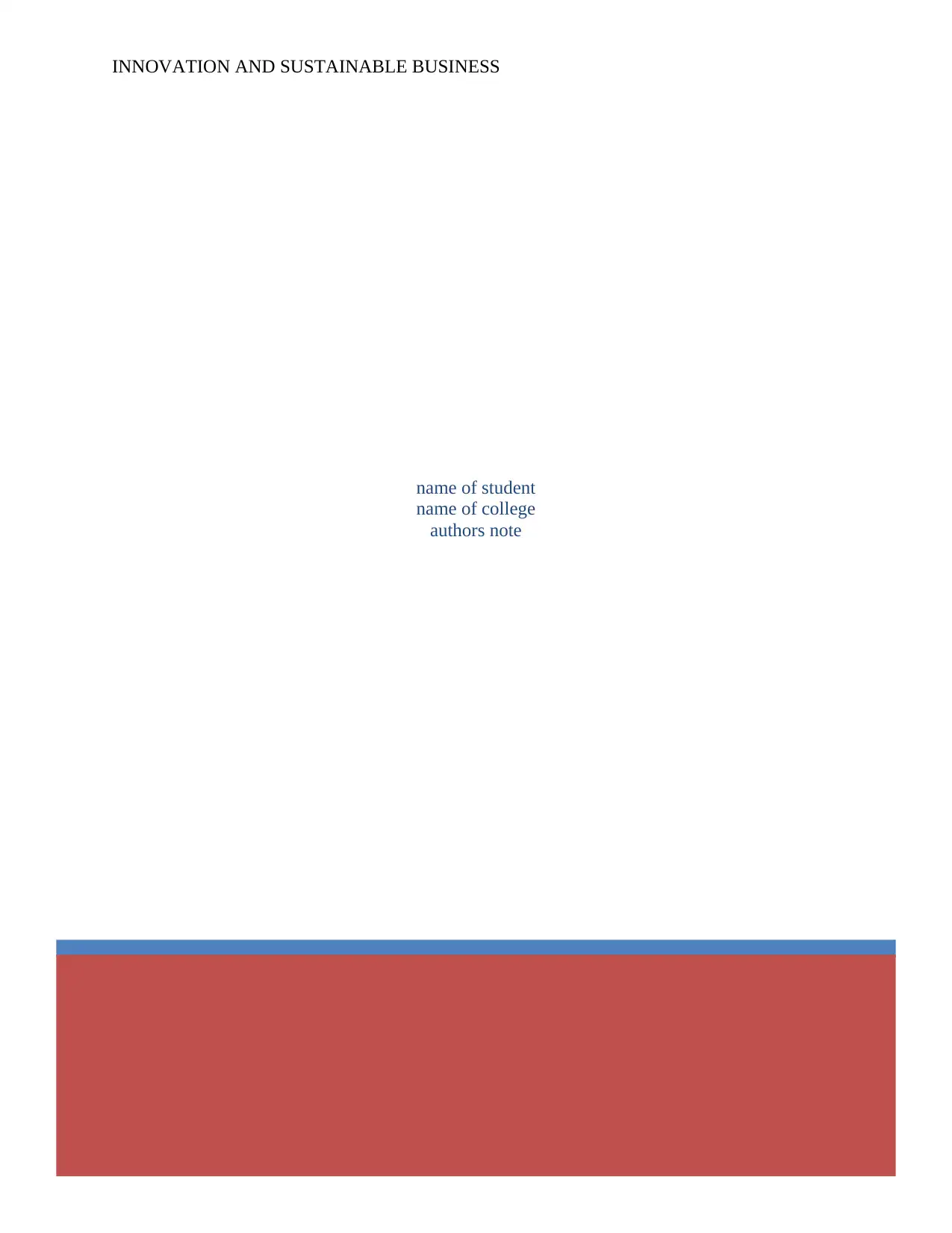
name of student
name of college
authors note
INNOVATION AND SUSTAINABLE BUSINESS
name of college
authors note
INNOVATION AND SUSTAINABLE BUSINESS
Secure Best Marks with AI Grader
Need help grading? Try our AI Grader for instant feedback on your assignments.

INNOVATION AND SUSTAINABLE BUSINESS
Executive Summary
In today’s intense competitive scenario every firm desires to stay ahead in race of creativity with
new ideas of innovation. As such innovate or die stands exact to current landscape as firms and
brands can only exist in dynamic market if they remain consistent in innovation and creativity to
offer something new with time in market always. But innovation and creativity is not an easy
task, so design thinking process is used for innovation as it meets to user needs and is prototype
centred process for innovation that is mostly suitable for product, service or business design. In
this report, deign thinking at Tesco is discussed to evaluate their innovation systems so that
understanding can be acquired to benefit the community and business with utilisation of this
approach.
1
Executive Summary
In today’s intense competitive scenario every firm desires to stay ahead in race of creativity with
new ideas of innovation. As such innovate or die stands exact to current landscape as firms and
brands can only exist in dynamic market if they remain consistent in innovation and creativity to
offer something new with time in market always. But innovation and creativity is not an easy
task, so design thinking process is used for innovation as it meets to user needs and is prototype
centred process for innovation that is mostly suitable for product, service or business design. In
this report, deign thinking at Tesco is discussed to evaluate their innovation systems so that
understanding can be acquired to benefit the community and business with utilisation of this
approach.
1
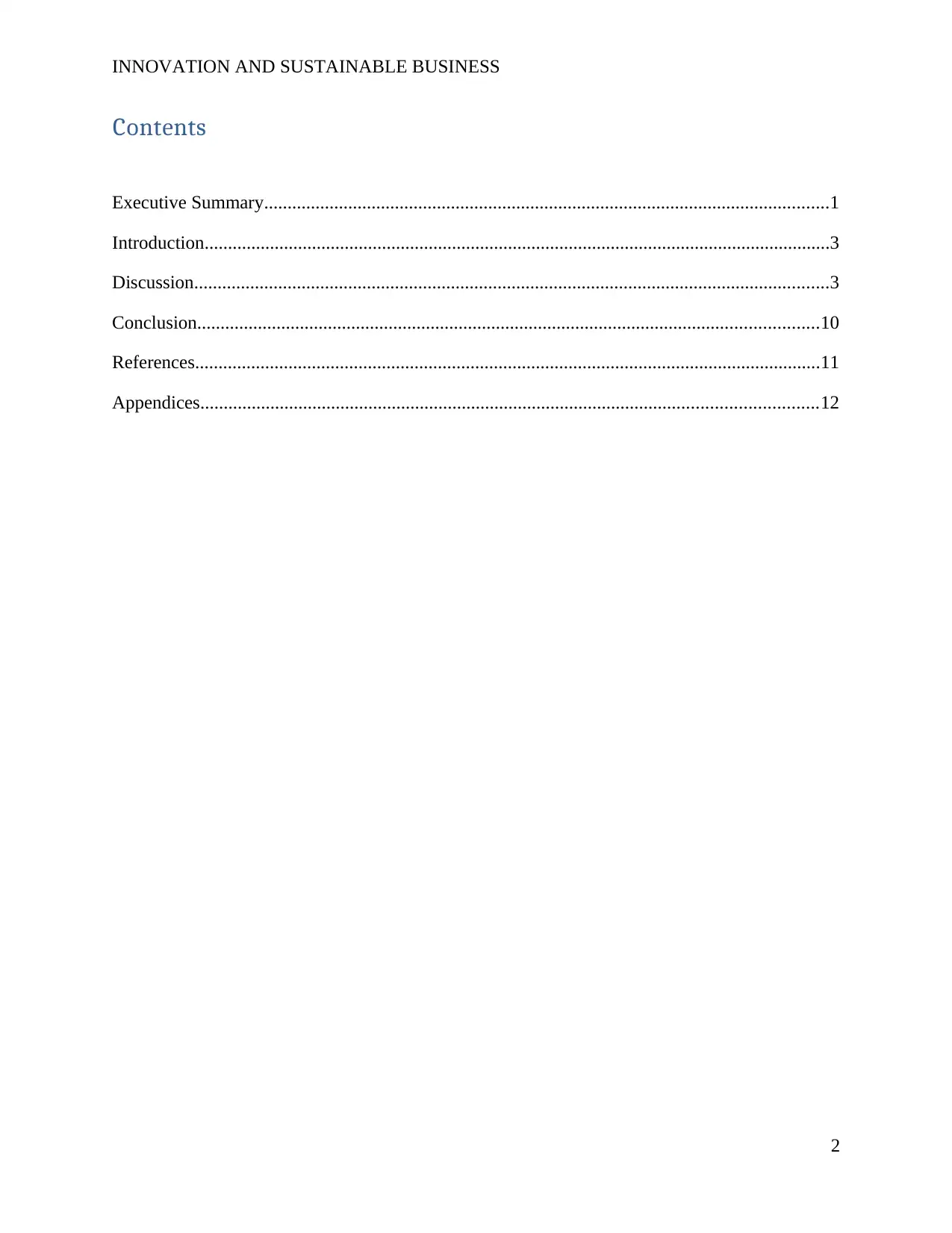
INNOVATION AND SUSTAINABLE BUSINESS
Contents
Executive Summary.........................................................................................................................1
Introduction......................................................................................................................................3
Discussion........................................................................................................................................3
Conclusion.....................................................................................................................................10
References......................................................................................................................................11
Appendices....................................................................................................................................12
2
Contents
Executive Summary.........................................................................................................................1
Introduction......................................................................................................................................3
Discussion........................................................................................................................................3
Conclusion.....................................................................................................................................10
References......................................................................................................................................11
Appendices....................................................................................................................................12
2
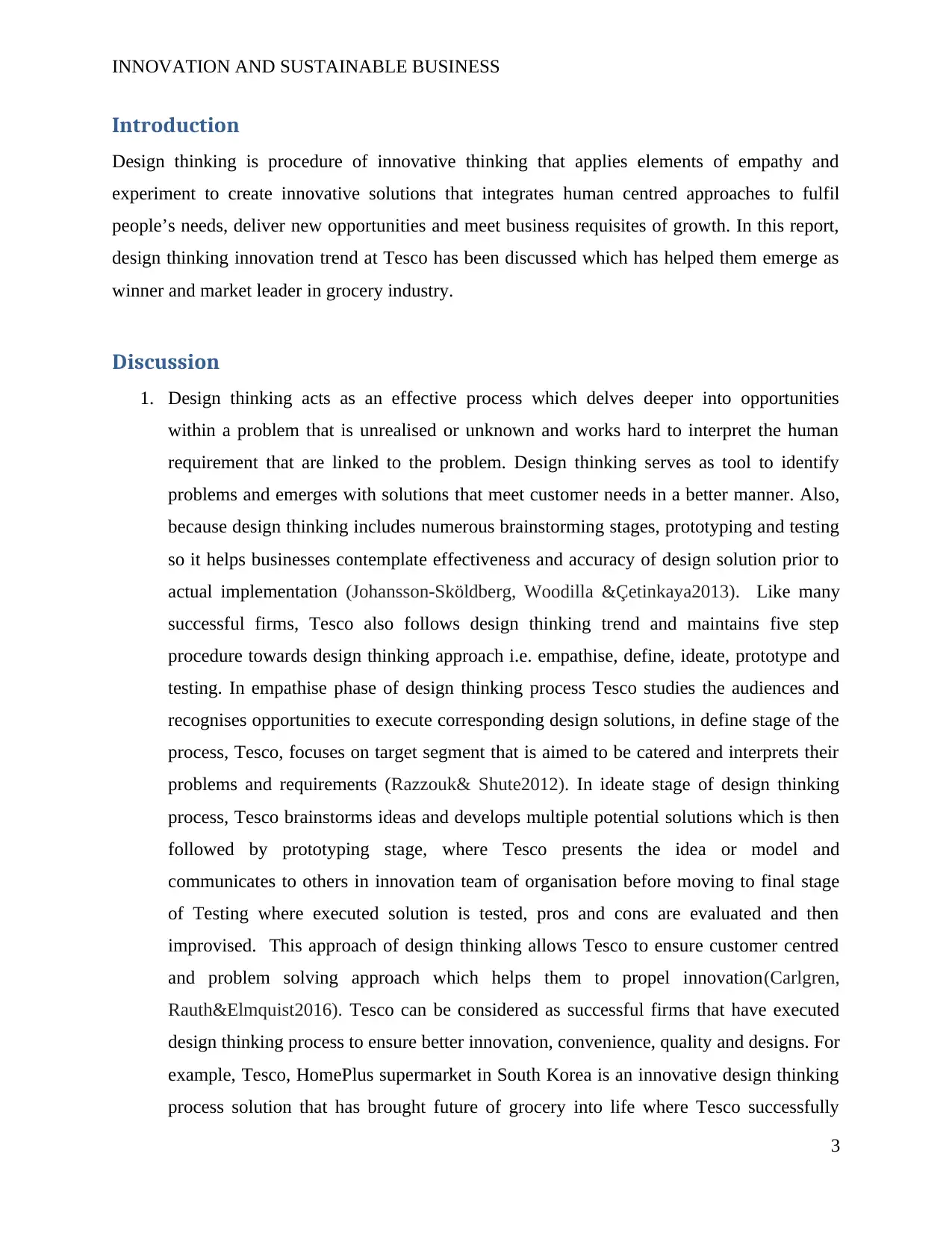
INNOVATION AND SUSTAINABLE BUSINESS
Introduction
Design thinking is procedure of innovative thinking that applies elements of empathy and
experiment to create innovative solutions that integrates human centred approaches to fulfil
people’s needs, deliver new opportunities and meet business requisites of growth. In this report,
design thinking innovation trend at Tesco has been discussed which has helped them emerge as
winner and market leader in grocery industry.
Discussion
1. Design thinking acts as an effective process which delves deeper into opportunities
within a problem that is unrealised or unknown and works hard to interpret the human
requirement that are linked to the problem. Design thinking serves as tool to identify
problems and emerges with solutions that meet customer needs in a better manner. Also,
because design thinking includes numerous brainstorming stages, prototyping and testing
so it helps businesses contemplate effectiveness and accuracy of design solution prior to
actual implementation (Johansson‐Sköldberg, Woodilla &Çetinkaya2013). Like many
successful firms, Tesco also follows design thinking trend and maintains five step
procedure towards design thinking approach i.e. empathise, define, ideate, prototype and
testing. In empathise phase of design thinking process Tesco studies the audiences and
recognises opportunities to execute corresponding design solutions, in define stage of the
process, Tesco, focuses on target segment that is aimed to be catered and interprets their
problems and requirements (Razzouk& Shute2012). In ideate stage of design thinking
process, Tesco brainstorms ideas and develops multiple potential solutions which is then
followed by prototyping stage, where Tesco presents the idea or model and
communicates to others in innovation team of organisation before moving to final stage
of Testing where executed solution is tested, pros and cons are evaluated and then
improvised. This approach of design thinking allows Tesco to ensure customer centred
and problem solving approach which helps them to propel innovation(Carlgren,
Rauth&Elmquist2016). Tesco can be considered as successful firms that have executed
design thinking process to ensure better innovation, convenience, quality and designs. For
example, Tesco, HomePlus supermarket in South Korea is an innovative design thinking
process solution that has brought future of grocery into life where Tesco successfully
3
Introduction
Design thinking is procedure of innovative thinking that applies elements of empathy and
experiment to create innovative solutions that integrates human centred approaches to fulfil
people’s needs, deliver new opportunities and meet business requisites of growth. In this report,
design thinking innovation trend at Tesco has been discussed which has helped them emerge as
winner and market leader in grocery industry.
Discussion
1. Design thinking acts as an effective process which delves deeper into opportunities
within a problem that is unrealised or unknown and works hard to interpret the human
requirement that are linked to the problem. Design thinking serves as tool to identify
problems and emerges with solutions that meet customer needs in a better manner. Also,
because design thinking includes numerous brainstorming stages, prototyping and testing
so it helps businesses contemplate effectiveness and accuracy of design solution prior to
actual implementation (Johansson‐Sköldberg, Woodilla &Çetinkaya2013). Like many
successful firms, Tesco also follows design thinking trend and maintains five step
procedure towards design thinking approach i.e. empathise, define, ideate, prototype and
testing. In empathise phase of design thinking process Tesco studies the audiences and
recognises opportunities to execute corresponding design solutions, in define stage of the
process, Tesco, focuses on target segment that is aimed to be catered and interprets their
problems and requirements (Razzouk& Shute2012). In ideate stage of design thinking
process, Tesco brainstorms ideas and develops multiple potential solutions which is then
followed by prototyping stage, where Tesco presents the idea or model and
communicates to others in innovation team of organisation before moving to final stage
of Testing where executed solution is tested, pros and cons are evaluated and then
improvised. This approach of design thinking allows Tesco to ensure customer centred
and problem solving approach which helps them to propel innovation(Carlgren,
Rauth&Elmquist2016). Tesco can be considered as successful firms that have executed
design thinking process to ensure better innovation, convenience, quality and designs. For
example, Tesco, HomePlus supermarket in South Korea is an innovative design thinking
process solution that has brought future of grocery into life where Tesco successfully
3
Secure Best Marks with AI Grader
Need help grading? Try our AI Grader for instant feedback on your assignments.
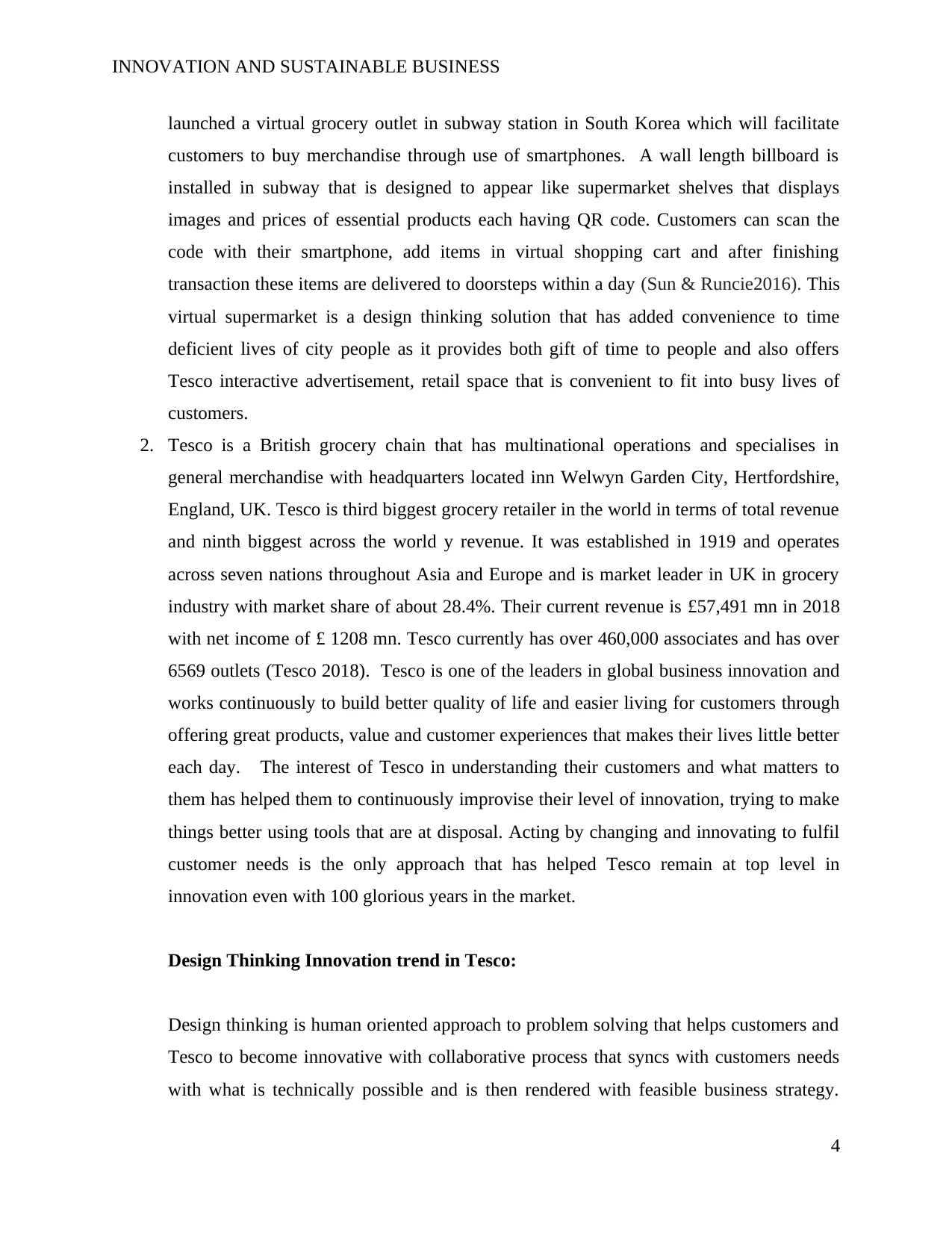
INNOVATION AND SUSTAINABLE BUSINESS
launched a virtual grocery outlet in subway station in South Korea which will facilitate
customers to buy merchandise through use of smartphones. A wall length billboard is
installed in subway that is designed to appear like supermarket shelves that displays
images and prices of essential products each having QR code. Customers can scan the
code with their smartphone, add items in virtual shopping cart and after finishing
transaction these items are delivered to doorsteps within a day (Sun & Runcie2016). This
virtual supermarket is a design thinking solution that has added convenience to time
deficient lives of city people as it provides both gift of time to people and also offers
Tesco interactive advertisement, retail space that is convenient to fit into busy lives of
customers.
2. Tesco is a British grocery chain that has multinational operations and specialises in
general merchandise with headquarters located inn Welwyn Garden City, Hertfordshire,
England, UK. Tesco is third biggest grocery retailer in the world in terms of total revenue
and ninth biggest across the world y revenue. It was established in 1919 and operates
across seven nations throughout Asia and Europe and is market leader in UK in grocery
industry with market share of about 28.4%. Their current revenue is £57,491 mn in 2018
with net income of £ 1208 mn. Tesco currently has over 460,000 associates and has over
6569 outlets (Tesco 2018). Tesco is one of the leaders in global business innovation and
works continuously to build better quality of life and easier living for customers through
offering great products, value and customer experiences that makes their lives little better
each day. The interest of Tesco in understanding their customers and what matters to
them has helped them to continuously improvise their level of innovation, trying to make
things better using tools that are at disposal. Acting by changing and innovating to fulfil
customer needs is the only approach that has helped Tesco remain at top level in
innovation even with 100 glorious years in the market.
Design Thinking Innovation trend in Tesco:
Design thinking is human oriented approach to problem solving that helps customers and
Tesco to become innovative with collaborative process that syncs with customers needs
with what is technically possible and is then rendered with feasible business strategy.
4
launched a virtual grocery outlet in subway station in South Korea which will facilitate
customers to buy merchandise through use of smartphones. A wall length billboard is
installed in subway that is designed to appear like supermarket shelves that displays
images and prices of essential products each having QR code. Customers can scan the
code with their smartphone, add items in virtual shopping cart and after finishing
transaction these items are delivered to doorsteps within a day (Sun & Runcie2016). This
virtual supermarket is a design thinking solution that has added convenience to time
deficient lives of city people as it provides both gift of time to people and also offers
Tesco interactive advertisement, retail space that is convenient to fit into busy lives of
customers.
2. Tesco is a British grocery chain that has multinational operations and specialises in
general merchandise with headquarters located inn Welwyn Garden City, Hertfordshire,
England, UK. Tesco is third biggest grocery retailer in the world in terms of total revenue
and ninth biggest across the world y revenue. It was established in 1919 and operates
across seven nations throughout Asia and Europe and is market leader in UK in grocery
industry with market share of about 28.4%. Their current revenue is £57,491 mn in 2018
with net income of £ 1208 mn. Tesco currently has over 460,000 associates and has over
6569 outlets (Tesco 2018). Tesco is one of the leaders in global business innovation and
works continuously to build better quality of life and easier living for customers through
offering great products, value and customer experiences that makes their lives little better
each day. The interest of Tesco in understanding their customers and what matters to
them has helped them to continuously improvise their level of innovation, trying to make
things better using tools that are at disposal. Acting by changing and innovating to fulfil
customer needs is the only approach that has helped Tesco remain at top level in
innovation even with 100 glorious years in the market.
Design Thinking Innovation trend in Tesco:
Design thinking is human oriented approach to problem solving that helps customers and
Tesco to become innovative with collaborative process that syncs with customers needs
with what is technically possible and is then rendered with feasible business strategy.
4

INNOVATION AND SUSTAINABLE BUSINESS
Design thinking innovation trend draws on logic, creativity, intuition and systemic
reasoning to explore opportunities for desirable results that can benefit customers in
improving their experiences or life (Furseth& Cuthbertson2013). The design thinking
innovation aspects at Tesco works on four principles that considers:
Human rule: all design practices are focused to be social in nature and these social
innovations emphasise human centred outlook.
Ambiguity rule: it is inevitable and cannot be over simplified, so experimenting within
limit of knowledge and capability is vital to focus on innovation with ability to
differentiate (Frow, Nenonen, Payne &Storbacka2015).
Redesign rule: every design is re-design because though technology and social landscape
may modify and evolve but basic human requirement keep unchanged, so Tesco only
redesigns the means to fulfil needs.
Tangibility rule: Tesco makes ideas tangible with prototypes that enable them to
communicate solution more efficaciously to people and customers.
Fig: Design thinking Innovation process at Tesco
Source: CreativitatWork.com (2019)
3. Concepts and relationship with design thinking innovation:
5
Design thinking innovation trend draws on logic, creativity, intuition and systemic
reasoning to explore opportunities for desirable results that can benefit customers in
improving their experiences or life (Furseth& Cuthbertson2013). The design thinking
innovation aspects at Tesco works on four principles that considers:
Human rule: all design practices are focused to be social in nature and these social
innovations emphasise human centred outlook.
Ambiguity rule: it is inevitable and cannot be over simplified, so experimenting within
limit of knowledge and capability is vital to focus on innovation with ability to
differentiate (Frow, Nenonen, Payne &Storbacka2015).
Redesign rule: every design is re-design because though technology and social landscape
may modify and evolve but basic human requirement keep unchanged, so Tesco only
redesigns the means to fulfil needs.
Tangibility rule: Tesco makes ideas tangible with prototypes that enable them to
communicate solution more efficaciously to people and customers.
Fig: Design thinking Innovation process at Tesco
Source: CreativitatWork.com (2019)
3. Concepts and relationship with design thinking innovation:
5
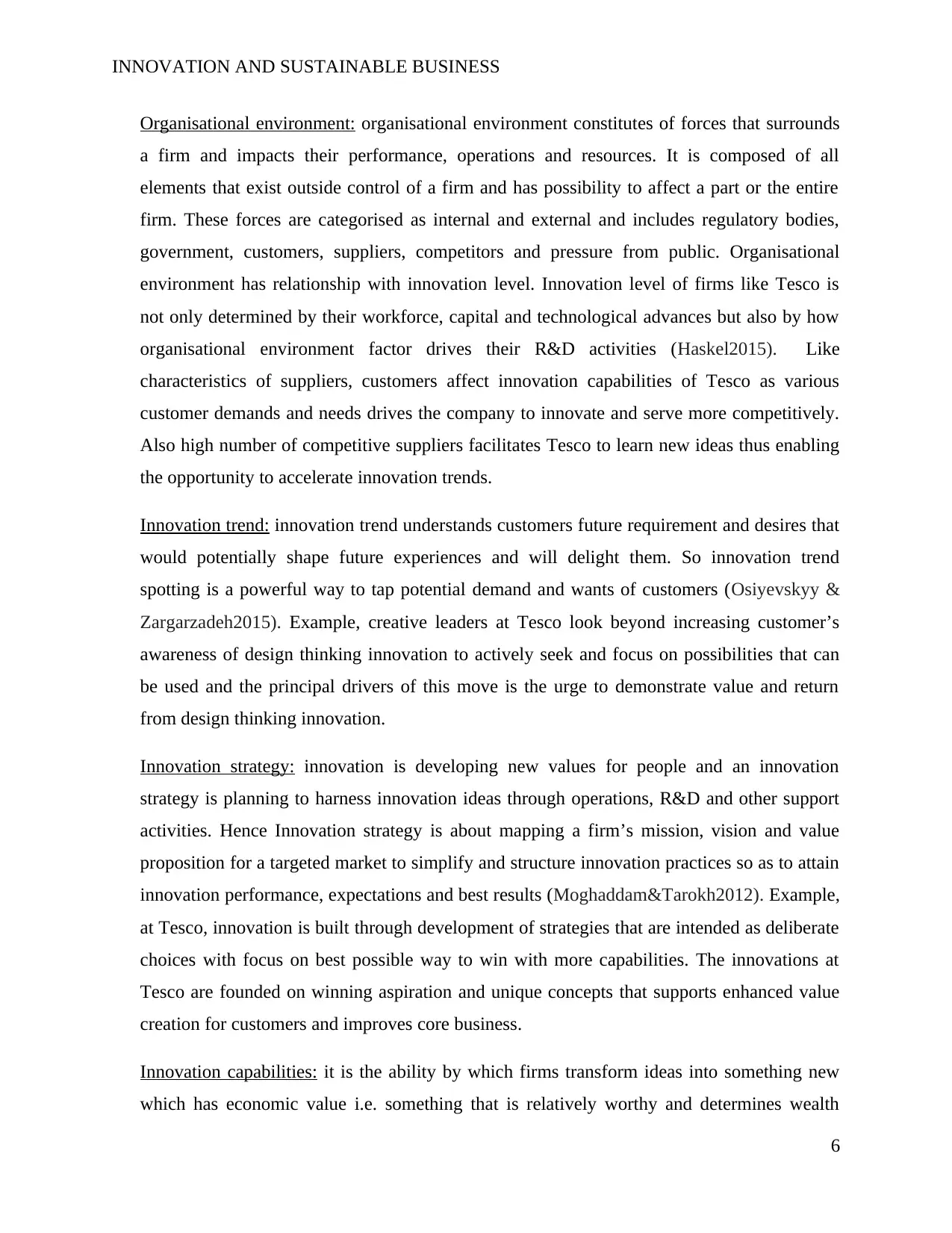
INNOVATION AND SUSTAINABLE BUSINESS
Organisational environment: organisational environment constitutes of forces that surrounds
a firm and impacts their performance, operations and resources. It is composed of all
elements that exist outside control of a firm and has possibility to affect a part or the entire
firm. These forces are categorised as internal and external and includes regulatory bodies,
government, customers, suppliers, competitors and pressure from public. Organisational
environment has relationship with innovation level. Innovation level of firms like Tesco is
not only determined by their workforce, capital and technological advances but also by how
organisational environment factor drives their R&D activities (Haskel2015). Like
characteristics of suppliers, customers affect innovation capabilities of Tesco as various
customer demands and needs drives the company to innovate and serve more competitively.
Also high number of competitive suppliers facilitates Tesco to learn new ideas thus enabling
the opportunity to accelerate innovation trends.
Innovation trend: innovation trend understands customers future requirement and desires that
would potentially shape future experiences and will delight them. So innovation trend
spotting is a powerful way to tap potential demand and wants of customers (Osiyevskyy &
Zargarzadeh2015). Example, creative leaders at Tesco look beyond increasing customer’s
awareness of design thinking innovation to actively seek and focus on possibilities that can
be used and the principal drivers of this move is the urge to demonstrate value and return
from design thinking innovation.
Innovation strategy: innovation is developing new values for people and an innovation
strategy is planning to harness innovation ideas through operations, R&D and other support
activities. Hence Innovation strategy is about mapping a firm’s mission, vision and value
proposition for a targeted market to simplify and structure innovation practices so as to attain
innovation performance, expectations and best results (Moghaddam&Tarokh2012). Example,
at Tesco, innovation is built through development of strategies that are intended as deliberate
choices with focus on best possible way to win with more capabilities. The innovations at
Tesco are founded on winning aspiration and unique concepts that supports enhanced value
creation for customers and improves core business.
Innovation capabilities: it is the ability by which firms transform ideas into something new
which has economic value i.e. something that is relatively worthy and determines wealth
6
Organisational environment: organisational environment constitutes of forces that surrounds
a firm and impacts their performance, operations and resources. It is composed of all
elements that exist outside control of a firm and has possibility to affect a part or the entire
firm. These forces are categorised as internal and external and includes regulatory bodies,
government, customers, suppliers, competitors and pressure from public. Organisational
environment has relationship with innovation level. Innovation level of firms like Tesco is
not only determined by their workforce, capital and technological advances but also by how
organisational environment factor drives their R&D activities (Haskel2015). Like
characteristics of suppliers, customers affect innovation capabilities of Tesco as various
customer demands and needs drives the company to innovate and serve more competitively.
Also high number of competitive suppliers facilitates Tesco to learn new ideas thus enabling
the opportunity to accelerate innovation trends.
Innovation trend: innovation trend understands customers future requirement and desires that
would potentially shape future experiences and will delight them. So innovation trend
spotting is a powerful way to tap potential demand and wants of customers (Osiyevskyy &
Zargarzadeh2015). Example, creative leaders at Tesco look beyond increasing customer’s
awareness of design thinking innovation to actively seek and focus on possibilities that can
be used and the principal drivers of this move is the urge to demonstrate value and return
from design thinking innovation.
Innovation strategy: innovation is developing new values for people and an innovation
strategy is planning to harness innovation ideas through operations, R&D and other support
activities. Hence Innovation strategy is about mapping a firm’s mission, vision and value
proposition for a targeted market to simplify and structure innovation practices so as to attain
innovation performance, expectations and best results (Moghaddam&Tarokh2012). Example,
at Tesco, innovation is built through development of strategies that are intended as deliberate
choices with focus on best possible way to win with more capabilities. The innovations at
Tesco are founded on winning aspiration and unique concepts that supports enhanced value
creation for customers and improves core business.
Innovation capabilities: it is the ability by which firms transform ideas into something new
which has economic value i.e. something that is relatively worthy and determines wealth
6
Paraphrase This Document
Need a fresh take? Get an instant paraphrase of this document with our AI Paraphraser
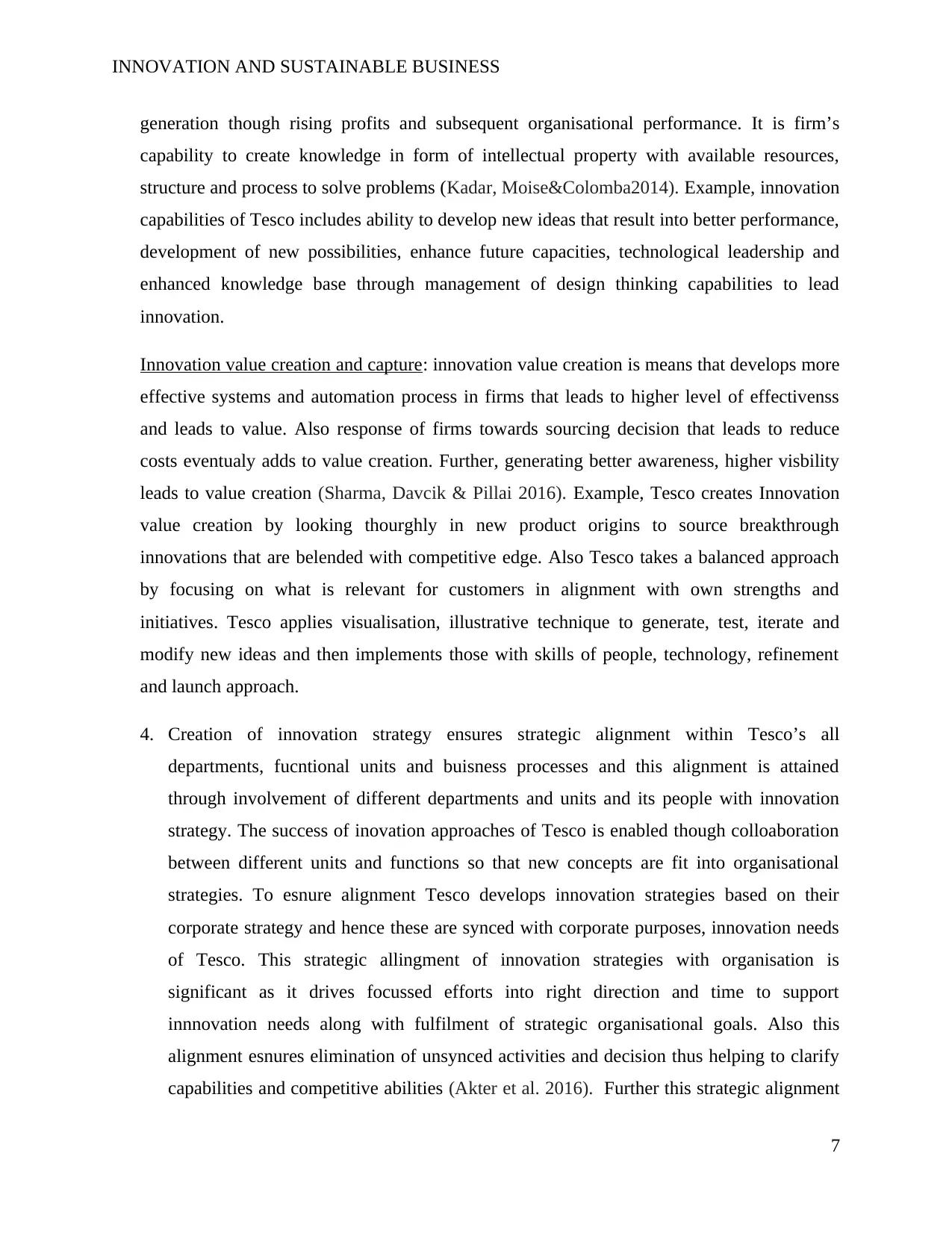
INNOVATION AND SUSTAINABLE BUSINESS
generation though rising profits and subsequent organisational performance. It is firm’s
capability to create knowledge in form of intellectual property with available resources,
structure and process to solve problems (Kadar, Moise&Colomba2014). Example, innovation
capabilities of Tesco includes ability to develop new ideas that result into better performance,
development of new possibilities, enhance future capacities, technological leadership and
enhanced knowledge base through management of design thinking capabilities to lead
innovation.
Innovation value creation and capture: innovation value creation is means that develops more
effective systems and automation process in firms that leads to higher level of effectivenss
and leads to value. Also response of firms towards sourcing decision that leads to reduce
costs eventualy adds to value creation. Further, generating better awareness, higher visbility
leads to value creation (Sharma, Davcik & Pillai 2016). Example, Tesco creates Innovation
value creation by looking thourghly in new product origins to source breakthrough
innovations that are belended with competitive edge. Also Tesco takes a balanced approach
by focusing on what is relevant for customers in alignment with own strengths and
initiatives. Tesco applies visualisation, illustrative technique to generate, test, iterate and
modify new ideas and then implements those with skills of people, technology, refinement
and launch approach.
4. Creation of innovation strategy ensures strategic alignment within Tesco’s all
departments, fucntional units and buisness processes and this alignment is attained
through involvement of different departments and units and its people with innovation
strategy. The success of inovation approaches of Tesco is enabled though colloaboration
between different units and functions so that new concepts are fit into organisational
strategies. To esnure alignment Tesco develops innovation strategies based on their
corporate strategy and hence these are synced with corporate purposes, innovation needs
of Tesco. This strategic allingment of innovation strategies with organisation is
significant as it drives focussed efforts into right direction and time to support
innnovation needs along with fulfilment of strategic organisational goals. Also this
alignment esnures elimination of unsynced activities and decision thus helping to clarify
capabilities and competitive abilities (Akter et al. 2016). Further this strategic alignment
7
generation though rising profits and subsequent organisational performance. It is firm’s
capability to create knowledge in form of intellectual property with available resources,
structure and process to solve problems (Kadar, Moise&Colomba2014). Example, innovation
capabilities of Tesco includes ability to develop new ideas that result into better performance,
development of new possibilities, enhance future capacities, technological leadership and
enhanced knowledge base through management of design thinking capabilities to lead
innovation.
Innovation value creation and capture: innovation value creation is means that develops more
effective systems and automation process in firms that leads to higher level of effectivenss
and leads to value. Also response of firms towards sourcing decision that leads to reduce
costs eventualy adds to value creation. Further, generating better awareness, higher visbility
leads to value creation (Sharma, Davcik & Pillai 2016). Example, Tesco creates Innovation
value creation by looking thourghly in new product origins to source breakthrough
innovations that are belended with competitive edge. Also Tesco takes a balanced approach
by focusing on what is relevant for customers in alignment with own strengths and
initiatives. Tesco applies visualisation, illustrative technique to generate, test, iterate and
modify new ideas and then implements those with skills of people, technology, refinement
and launch approach.
4. Creation of innovation strategy ensures strategic alignment within Tesco’s all
departments, fucntional units and buisness processes and this alignment is attained
through involvement of different departments and units and its people with innovation
strategy. The success of inovation approaches of Tesco is enabled though colloaboration
between different units and functions so that new concepts are fit into organisational
strategies. To esnure alignment Tesco develops innovation strategies based on their
corporate strategy and hence these are synced with corporate purposes, innovation needs
of Tesco. This strategic allingment of innovation strategies with organisation is
significant as it drives focussed efforts into right direction and time to support
innnovation needs along with fulfilment of strategic organisational goals. Also this
alignment esnures elimination of unsynced activities and decision thus helping to clarify
capabilities and competitive abilities (Akter et al. 2016). Further this strategic alignment
7
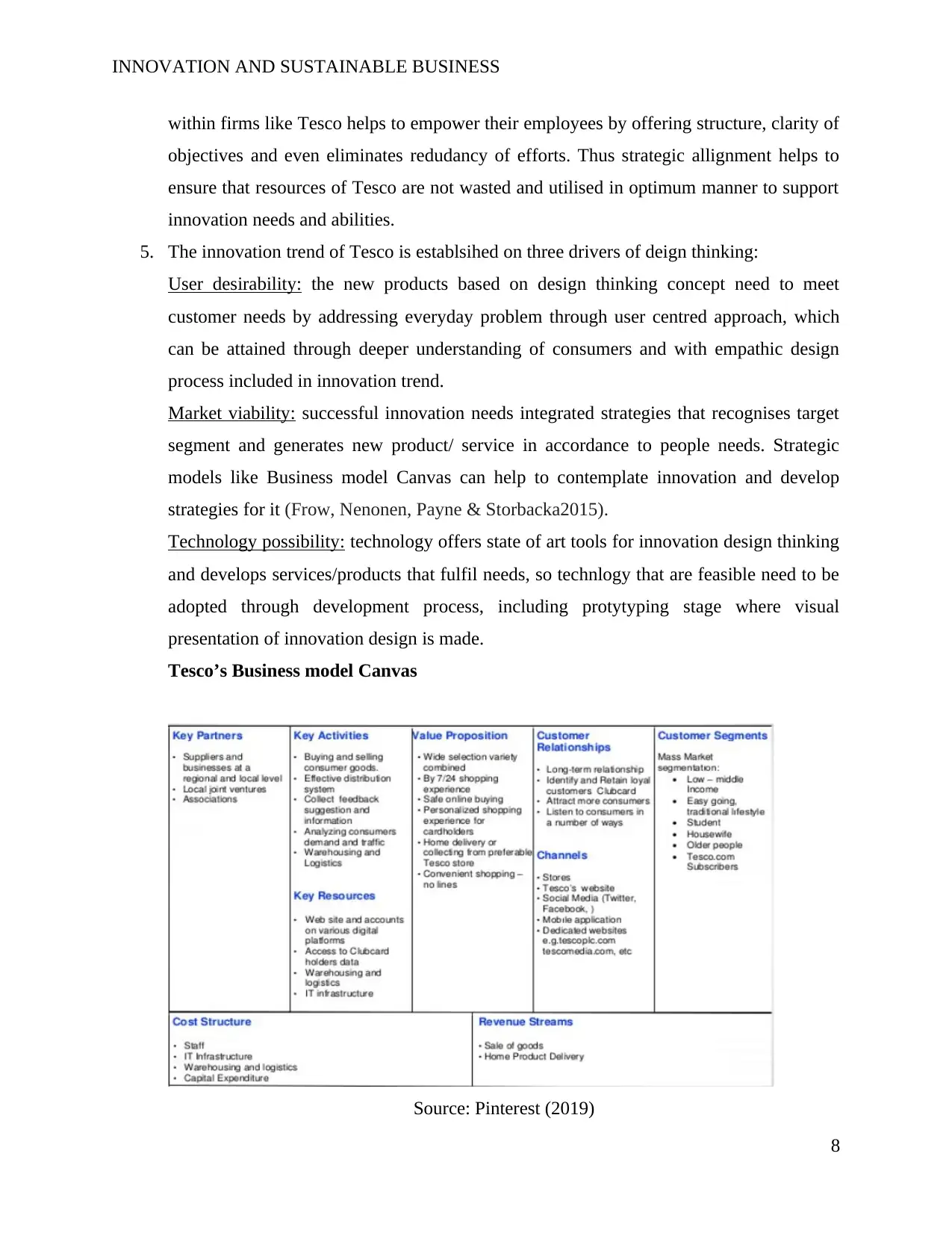
INNOVATION AND SUSTAINABLE BUSINESS
within firms like Tesco helps to empower their employees by offering structure, clarity of
objectives and even eliminates redudancy of efforts. Thus strategic allignment helps to
ensure that resources of Tesco are not wasted and utilised in optimum manner to support
innovation needs and abilities.
5. The innovation trend of Tesco is establsihed on three drivers of deign thinking:
User desirability: the new products based on design thinking concept need to meet
customer needs by addressing everyday problem through user centred approach, which
can be attained through deeper understanding of consumers and with empathic design
process included in innovation trend.
Market viability: successful innovation needs integrated strategies that recognises target
segment and generates new product/ service in accordance to people needs. Strategic
models like Business model Canvas can help to contemplate innovation and develop
strategies for it (Frow, Nenonen, Payne & Storbacka2015).
Technology possibility: technology offers state of art tools for innovation design thinking
and develops services/products that fulfil needs, so technlogy that are feasible need to be
adopted through development process, including protytyping stage where visual
presentation of innovation design is made.
Tesco’s Business model Canvas
Source: Pinterest (2019)
8
within firms like Tesco helps to empower their employees by offering structure, clarity of
objectives and even eliminates redudancy of efforts. Thus strategic allignment helps to
ensure that resources of Tesco are not wasted and utilised in optimum manner to support
innovation needs and abilities.
5. The innovation trend of Tesco is establsihed on three drivers of deign thinking:
User desirability: the new products based on design thinking concept need to meet
customer needs by addressing everyday problem through user centred approach, which
can be attained through deeper understanding of consumers and with empathic design
process included in innovation trend.
Market viability: successful innovation needs integrated strategies that recognises target
segment and generates new product/ service in accordance to people needs. Strategic
models like Business model Canvas can help to contemplate innovation and develop
strategies for it (Frow, Nenonen, Payne & Storbacka2015).
Technology possibility: technology offers state of art tools for innovation design thinking
and develops services/products that fulfil needs, so technlogy that are feasible need to be
adopted through development process, including protytyping stage where visual
presentation of innovation design is made.
Tesco’s Business model Canvas
Source: Pinterest (2019)
8
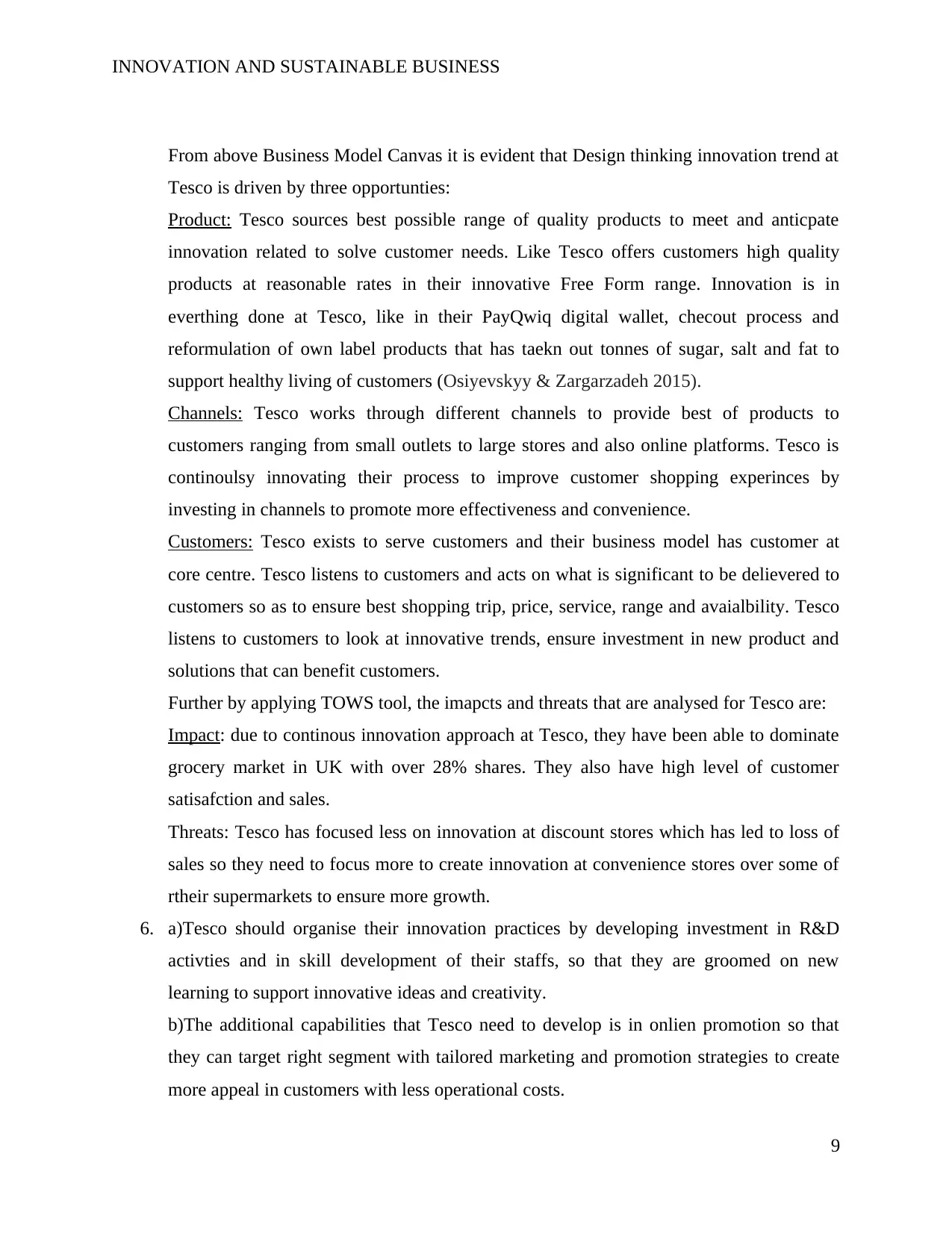
INNOVATION AND SUSTAINABLE BUSINESS
From above Business Model Canvas it is evident that Design thinking innovation trend at
Tesco is driven by three opportunties:
Product: Tesco sources best possible range of quality products to meet and anticpate
innovation related to solve customer needs. Like Tesco offers customers high quality
products at reasonable rates in their innovative Free Form range. Innovation is in
everthing done at Tesco, like in their PayQwiq digital wallet, checout process and
reformulation of own label products that has taekn out tonnes of sugar, salt and fat to
support healthy living of customers (Osiyevskyy & Zargarzadeh 2015).
Channels: Tesco works through different channels to provide best of products to
customers ranging from small outlets to large stores and also online platforms. Tesco is
continoulsy innovating their process to improve customer shopping experinces by
investing in channels to promote more effectiveness and convenience.
Customers: Tesco exists to serve customers and their business model has customer at
core centre. Tesco listens to customers and acts on what is significant to be delievered to
customers so as to ensure best shopping trip, price, service, range and avaialbility. Tesco
listens to customers to look at innovative trends, ensure investment in new product and
solutions that can benefit customers.
Further by applying TOWS tool, the imapcts and threats that are analysed for Tesco are:
Impact: due to continous innovation approach at Tesco, they have been able to dominate
grocery market in UK with over 28% shares. They also have high level of customer
satisafction and sales.
Threats: Tesco has focused less on innovation at discount stores which has led to loss of
sales so they need to focus more to create innovation at convenience stores over some of
rtheir supermarkets to ensure more growth.
6. a)Tesco should organise their innovation practices by developing investment in R&D
activties and in skill development of their staffs, so that they are groomed on new
learning to support innovative ideas and creativity.
b)The additional capabilities that Tesco need to develop is in onlien promotion so that
they can target right segment with tailored marketing and promotion strategies to create
more appeal in customers with less operational costs.
9
From above Business Model Canvas it is evident that Design thinking innovation trend at
Tesco is driven by three opportunties:
Product: Tesco sources best possible range of quality products to meet and anticpate
innovation related to solve customer needs. Like Tesco offers customers high quality
products at reasonable rates in their innovative Free Form range. Innovation is in
everthing done at Tesco, like in their PayQwiq digital wallet, checout process and
reformulation of own label products that has taekn out tonnes of sugar, salt and fat to
support healthy living of customers (Osiyevskyy & Zargarzadeh 2015).
Channels: Tesco works through different channels to provide best of products to
customers ranging from small outlets to large stores and also online platforms. Tesco is
continoulsy innovating their process to improve customer shopping experinces by
investing in channels to promote more effectiveness and convenience.
Customers: Tesco exists to serve customers and their business model has customer at
core centre. Tesco listens to customers and acts on what is significant to be delievered to
customers so as to ensure best shopping trip, price, service, range and avaialbility. Tesco
listens to customers to look at innovative trends, ensure investment in new product and
solutions that can benefit customers.
Further by applying TOWS tool, the imapcts and threats that are analysed for Tesco are:
Impact: due to continous innovation approach at Tesco, they have been able to dominate
grocery market in UK with over 28% shares. They also have high level of customer
satisafction and sales.
Threats: Tesco has focused less on innovation at discount stores which has led to loss of
sales so they need to focus more to create innovation at convenience stores over some of
rtheir supermarkets to ensure more growth.
6. a)Tesco should organise their innovation practices by developing investment in R&D
activties and in skill development of their staffs, so that they are groomed on new
learning to support innovative ideas and creativity.
b)The additional capabilities that Tesco need to develop is in onlien promotion so that
they can target right segment with tailored marketing and promotion strategies to create
more appeal in customers with less operational costs.
9
Secure Best Marks with AI Grader
Need help grading? Try our AI Grader for instant feedback on your assignments.
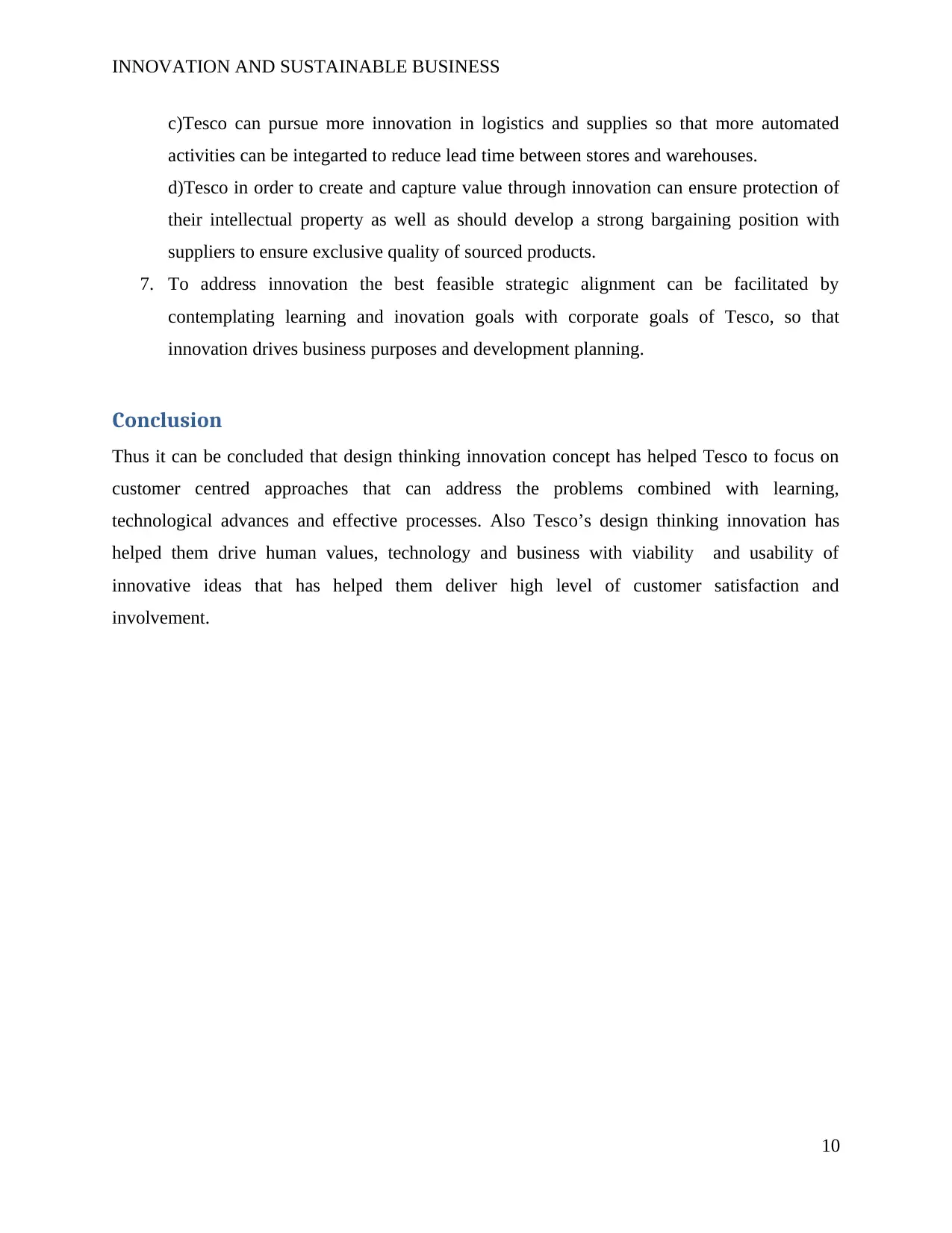
INNOVATION AND SUSTAINABLE BUSINESS
c)Tesco can pursue more innovation in logistics and supplies so that more automated
activities can be integarted to reduce lead time between stores and warehouses.
d)Tesco in order to create and capture value through innovation can ensure protection of
their intellectual property as well as should develop a strong bargaining position with
suppliers to ensure exclusive quality of sourced products.
7. To address innovation the best feasible strategic alignment can be facilitated by
contemplating learning and inovation goals with corporate goals of Tesco, so that
innovation drives business purposes and development planning.
Conclusion
Thus it can be concluded that design thinking innovation concept has helped Tesco to focus on
customer centred approaches that can address the problems combined with learning,
technological advances and effective processes. Also Tesco’s design thinking innovation has
helped them drive human values, technology and business with viability and usability of
innovative ideas that has helped them deliver high level of customer satisfaction and
involvement.
10
c)Tesco can pursue more innovation in logistics and supplies so that more automated
activities can be integarted to reduce lead time between stores and warehouses.
d)Tesco in order to create and capture value through innovation can ensure protection of
their intellectual property as well as should develop a strong bargaining position with
suppliers to ensure exclusive quality of sourced products.
7. To address innovation the best feasible strategic alignment can be facilitated by
contemplating learning and inovation goals with corporate goals of Tesco, so that
innovation drives business purposes and development planning.
Conclusion
Thus it can be concluded that design thinking innovation concept has helped Tesco to focus on
customer centred approaches that can address the problems combined with learning,
technological advances and effective processes. Also Tesco’s design thinking innovation has
helped them drive human values, technology and business with viability and usability of
innovative ideas that has helped them deliver high level of customer satisfaction and
involvement.
10
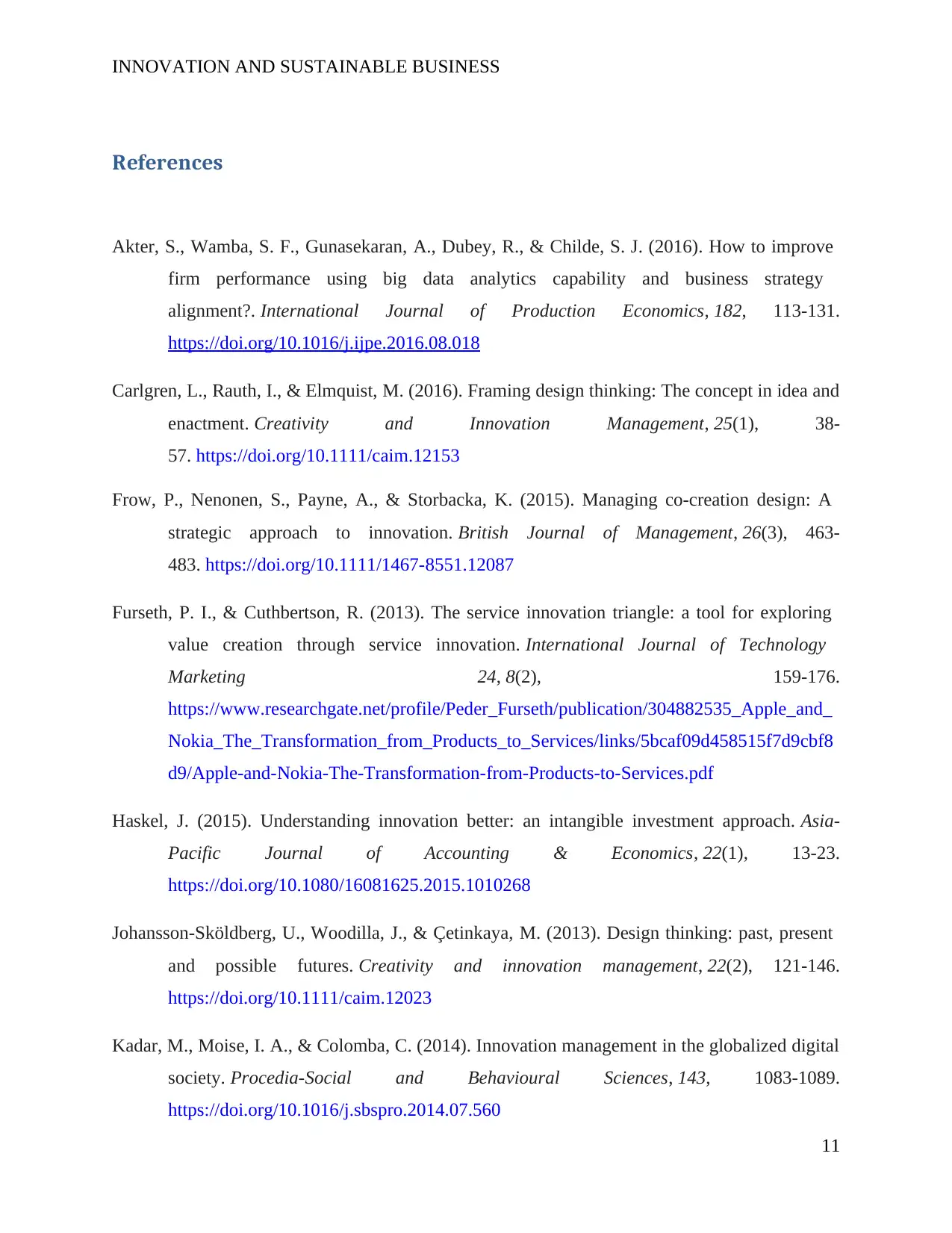
INNOVATION AND SUSTAINABLE BUSINESS
References
Akter, S., Wamba, S. F., Gunasekaran, A., Dubey, R., & Childe, S. J. (2016). How to improve
firm performance using big data analytics capability and business strategy
alignment?. International Journal of Production Economics, 182, 113-131.
https://doi.org/10.1016/j.ijpe.2016.08.018
Carlgren, L., Rauth, I., & Elmquist, M. (2016). Framing design thinking: The concept in idea and
enactment. Creativity and Innovation Management, 25(1), 38-
57. https://doi.org/10.1111/caim.12153
Frow, P., Nenonen, S., Payne, A., & Storbacka, K. (2015). Managing co‐creation design: A
strategic approach to innovation. British Journal of Management, 26(3), 463-
483. https://doi.org/10.1111/1467-8551.12087
Furseth, P. I., & Cuthbertson, R. (2013). The service innovation triangle: a tool for exploring
value creation through service innovation. International Journal of Technology
Marketing 24, 8(2), 159-176.
https://www.researchgate.net/profile/Peder_Furseth/publication/304882535_Apple_and_
Nokia_The_Transformation_from_Products_to_Services/links/5bcaf09d458515f7d9cbf8
d9/Apple-and-Nokia-The-Transformation-from-Products-to-Services.pdf
Haskel, J. (2015). Understanding innovation better: an intangible investment approach. Asia-
Pacific Journal of Accounting & Economics, 22(1), 13-23.
https://doi.org/10.1080/16081625.2015.1010268
Johansson‐Sköldberg, U., Woodilla, J., & Çetinkaya, M. (2013). Design thinking: past, present
and possible futures. Creativity and innovation management, 22(2), 121-146.
https://doi.org/10.1111/caim.12023
Kadar, M., Moise, I. A., & Colomba, C. (2014). Innovation management in the globalized digital
society. Procedia-Social and Behavioural Sciences, 143, 1083-1089.
https://doi.org/10.1016/j.sbspro.2014.07.560
11
References
Akter, S., Wamba, S. F., Gunasekaran, A., Dubey, R., & Childe, S. J. (2016). How to improve
firm performance using big data analytics capability and business strategy
alignment?. International Journal of Production Economics, 182, 113-131.
https://doi.org/10.1016/j.ijpe.2016.08.018
Carlgren, L., Rauth, I., & Elmquist, M. (2016). Framing design thinking: The concept in idea and
enactment. Creativity and Innovation Management, 25(1), 38-
57. https://doi.org/10.1111/caim.12153
Frow, P., Nenonen, S., Payne, A., & Storbacka, K. (2015). Managing co‐creation design: A
strategic approach to innovation. British Journal of Management, 26(3), 463-
483. https://doi.org/10.1111/1467-8551.12087
Furseth, P. I., & Cuthbertson, R. (2013). The service innovation triangle: a tool for exploring
value creation through service innovation. International Journal of Technology
Marketing 24, 8(2), 159-176.
https://www.researchgate.net/profile/Peder_Furseth/publication/304882535_Apple_and_
Nokia_The_Transformation_from_Products_to_Services/links/5bcaf09d458515f7d9cbf8
d9/Apple-and-Nokia-The-Transformation-from-Products-to-Services.pdf
Haskel, J. (2015). Understanding innovation better: an intangible investment approach. Asia-
Pacific Journal of Accounting & Economics, 22(1), 13-23.
https://doi.org/10.1080/16081625.2015.1010268
Johansson‐Sköldberg, U., Woodilla, J., & Çetinkaya, M. (2013). Design thinking: past, present
and possible futures. Creativity and innovation management, 22(2), 121-146.
https://doi.org/10.1111/caim.12023
Kadar, M., Moise, I. A., & Colomba, C. (2014). Innovation management in the globalized digital
society. Procedia-Social and Behavioural Sciences, 143, 1083-1089.
https://doi.org/10.1016/j.sbspro.2014.07.560
11
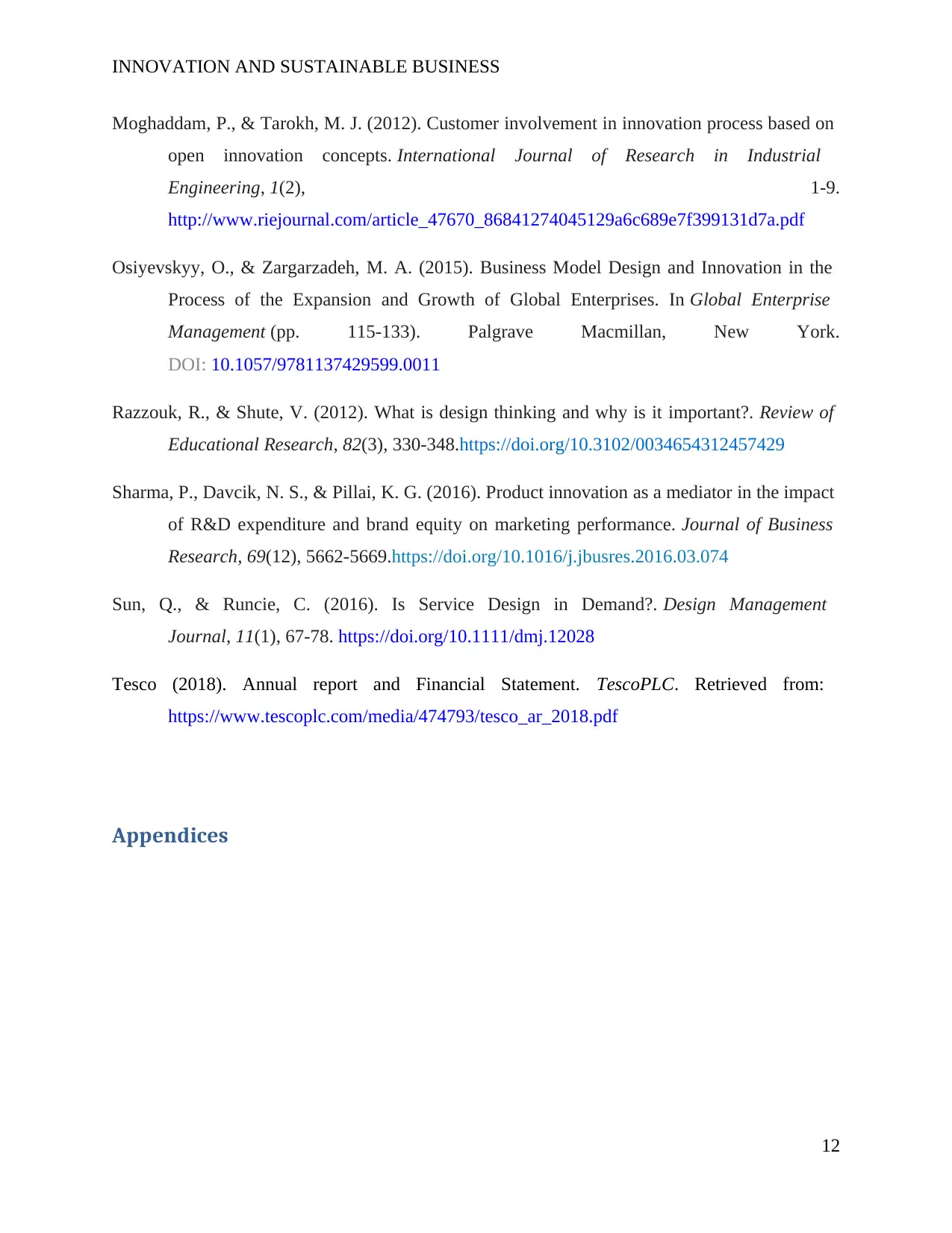
INNOVATION AND SUSTAINABLE BUSINESS
Moghaddam, P., & Tarokh, M. J. (2012). Customer involvement in innovation process based on
open innovation concepts. International Journal of Research in Industrial
Engineering, 1(2), 1-9.
http://www.riejournal.com/article_47670_86841274045129a6c689e7f399131d7a.pdf
Osiyevskyy, O., & Zargarzadeh, M. A. (2015). Business Model Design and Innovation in the
Process of the Expansion and Growth of Global Enterprises. In Global Enterprise
Management (pp. 115-133). Palgrave Macmillan, New York.
DOI: 10.1057/9781137429599.0011
Razzouk, R., & Shute, V. (2012). What is design thinking and why is it important?. Review of
Educational Research, 82(3), 330-348.https://doi.org/10.3102/0034654312457429
Sharma, P., Davcik, N. S., & Pillai, K. G. (2016). Product innovation as a mediator in the impact
of R&D expenditure and brand equity on marketing performance. Journal of Business
Research, 69(12), 5662-5669.https://doi.org/10.1016/j.jbusres.2016.03.074
Sun, Q., & Runcie, C. (2016). Is Service Design in Demand?. Design Management
Journal, 11(1), 67-78. https://doi.org/10.1111/dmj.12028
Tesco (2018). Annual report and Financial Statement. TescoPLC. Retrieved from:
https://www.tescoplc.com/media/474793/tesco_ar_2018.pdf
Appendices
12
Moghaddam, P., & Tarokh, M. J. (2012). Customer involvement in innovation process based on
open innovation concepts. International Journal of Research in Industrial
Engineering, 1(2), 1-9.
http://www.riejournal.com/article_47670_86841274045129a6c689e7f399131d7a.pdf
Osiyevskyy, O., & Zargarzadeh, M. A. (2015). Business Model Design and Innovation in the
Process of the Expansion and Growth of Global Enterprises. In Global Enterprise
Management (pp. 115-133). Palgrave Macmillan, New York.
DOI: 10.1057/9781137429599.0011
Razzouk, R., & Shute, V. (2012). What is design thinking and why is it important?. Review of
Educational Research, 82(3), 330-348.https://doi.org/10.3102/0034654312457429
Sharma, P., Davcik, N. S., & Pillai, K. G. (2016). Product innovation as a mediator in the impact
of R&D expenditure and brand equity on marketing performance. Journal of Business
Research, 69(12), 5662-5669.https://doi.org/10.1016/j.jbusres.2016.03.074
Sun, Q., & Runcie, C. (2016). Is Service Design in Demand?. Design Management
Journal, 11(1), 67-78. https://doi.org/10.1111/dmj.12028
Tesco (2018). Annual report and Financial Statement. TescoPLC. Retrieved from:
https://www.tescoplc.com/media/474793/tesco_ar_2018.pdf
Appendices
12
Paraphrase This Document
Need a fresh take? Get an instant paraphrase of this document with our AI Paraphraser
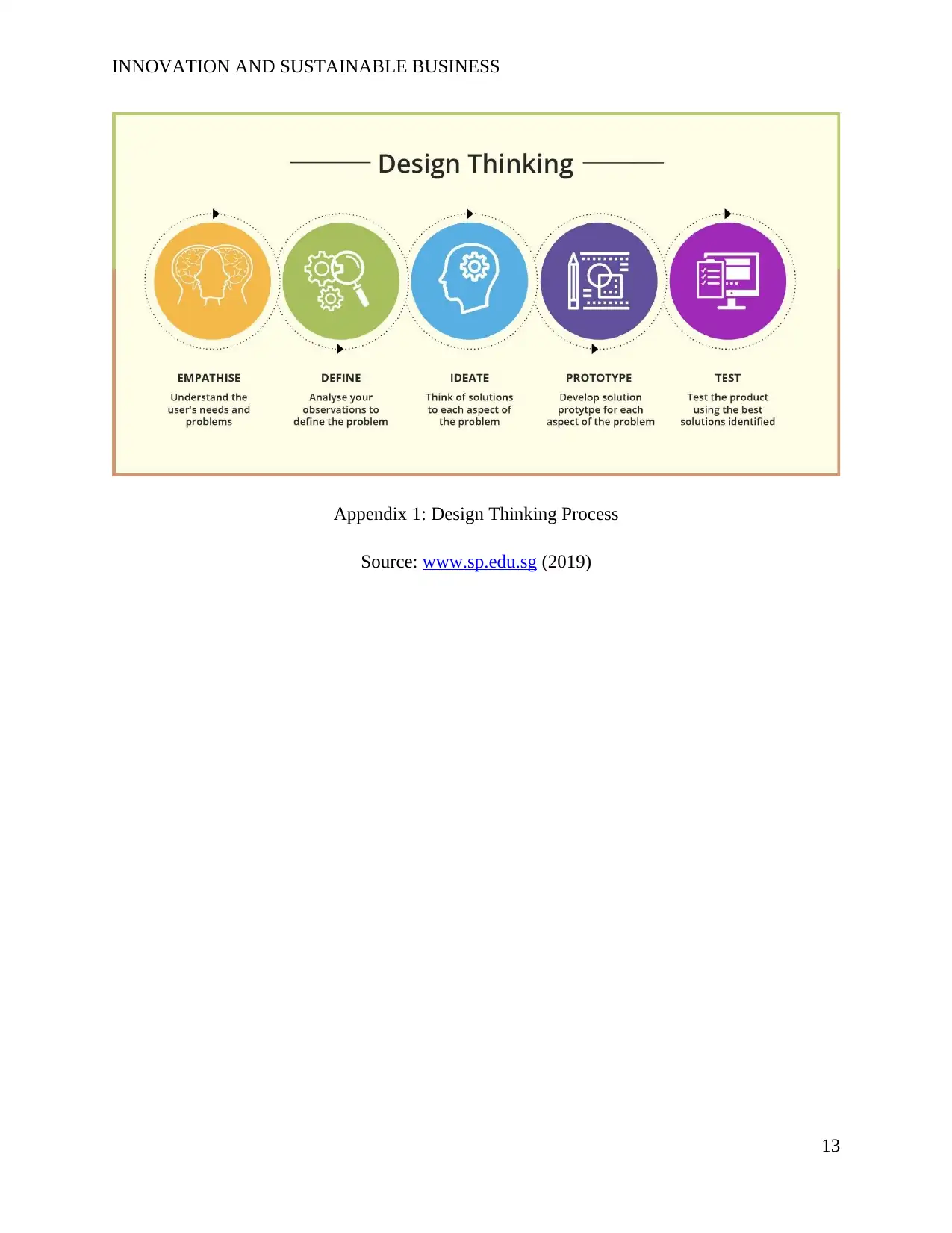
INNOVATION AND SUSTAINABLE BUSINESS
Appendix 1: Design Thinking Process
Source: www.sp.edu.sg (2019)
13
Appendix 1: Design Thinking Process
Source: www.sp.edu.sg (2019)
13
1 out of 14
Related Documents
Your All-in-One AI-Powered Toolkit for Academic Success.
+13062052269
info@desklib.com
Available 24*7 on WhatsApp / Email
![[object Object]](/_next/static/media/star-bottom.7253800d.svg)
Unlock your academic potential
© 2024 | Zucol Services PVT LTD | All rights reserved.





